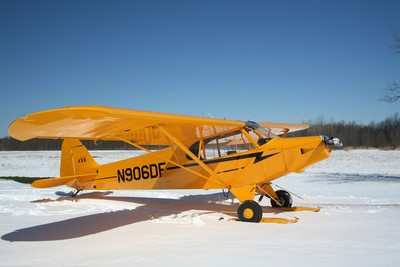Leaf-Spring Landing Gear Failures Have Increased, FAA Says
 The FAA has published a Safety Alert For Operators (SAFO) for
airplanes with leaf-spring landing gear which have been modified
with oversized "tundra" tires, skis, or a combination of the
two.
The FAA has published a Safety Alert For Operators (SAFO) for
airplanes with leaf-spring landing gear which have been modified
with oversized "tundra" tires, skis, or a combination of the
two.
The FAA notes that many aircraft operating in harsh and/or rough
terrain environments have obtained approval for installation of
wheel/tire combinations larger than originally certificated. These
wheel/tire combinations are commonly referred to as tundra tire
modifications. Modifications also include the installation of ski
and wheel/ski modifications to better adapt to a particular flying
environment.
There has been an increase of structural failures on aircraft
operating with these modifications, according to the SAFO. To date
there are at least 32 documented accidents caused by failure of the
landing gear leg near the attachment holes of the axle. Based on
statistical data the expectation is that under current conditions
approximately 15 additional accidents will occur on aircraft with
leaf spring gear having tundra tire, ski, and wheel/ski
modifications producing a potential risk for serious or fatal
injuries to occur.
The SAFO notes that with a wide range of operating parameters,
it is not always possible to predict the affects of vibration,
harmonics, drag, loading, or other characteristics induced by
aircraft operating with these configurations. Therefore, it is
incumbent on the operator to understand the potential risks and
take appropriate measures for safe operation of the aircraft.
The FAA published guidance in Advisory Circular (AC) 23-17,
Systems and Equipment Guide for Certification of Part 23 Airplanes
and Airships, summarizing flight test results, possible safety
hazards, and general information about certification of aircraft
with oversized tundra tires. This information is useful for other
aircraft installations even though the test aircraft for the data
collected was primarily a Piper PA-18.

Legend Cub Equipped With Skis
The SAFO urges that persons interested in operating aircraft
with oversize tundra tire, ski, or wheel/ski installations should
be aware of the safety risks involved and take appropriate measures
to reduce those risks.
The FAA recommends the following actions for aircraft so
equipped:
- Inspect the area of the axle attaching holes for cracks,
corrosion, and any other defect that might induce failure.
Performance of these inspections should be in accordance with
“best practices” commonly used in industry with, at a
minimum, the use of a dye penetrant method of nondestructive
testing (NDT) with the aide of magnification, or other methods
techniques and practices acceptable to the FAA.
- Corrosion, fatigue, and/or hardware substitution can be
detrimental to other areas of the strut as well and the
manufacturer’s recommendations should be thoroughly reviewed
and understood. Compatibility of materials should be considered.
Particularly, when aircraft have been modified with components of
different base metals than originally certified, such as
titanium/cadmium combinations or other noncompatible materials. The
effects of time in service on hardware should be considered and
replacement intervals established.
- Aircraft in service with these modifications should have an
increased inspection frequency with records maintained to indicate
the method and status since last inspection.
- Instructions for Continued Airworthiness (ICA) are required for
continuous operation of the aircraft. Apply careful consideration
when developing maintenance and inspection procedures that define
the methods, techniques, and practices used in determining safe
operation of the aircraft.
- When establishing the frequency of these repetitive
inspections, special consideration should be given to the number of
hours flown, type of flying, operational environment, age, and
previous operating history of the aircraft.
Aircraft operators who obtained approval for these installations
prior to the data package requirement for field approval or ICA
requirement for supplemental type certificate (STC) are encouraged
to develop an ICA for their aircraft.
 Bolen Gives Congress a Rare Thumbs-Up
Bolen Gives Congress a Rare Thumbs-Up The SportPlane Resource Guide RETURNS!!!!
The SportPlane Resource Guide RETURNS!!!! Buying Sprees Continue: Textron eAviation Takes On Amazilia Aerospace
Buying Sprees Continue: Textron eAviation Takes On Amazilia Aerospace Hawker 4000 Bizjets Gain Nav System, Data Link STC
Hawker 4000 Bizjets Gain Nav System, Data Link STC Echodyne Gets BVLOS Waiver for AiRanger Aircraft
Echodyne Gets BVLOS Waiver for AiRanger Aircraft




